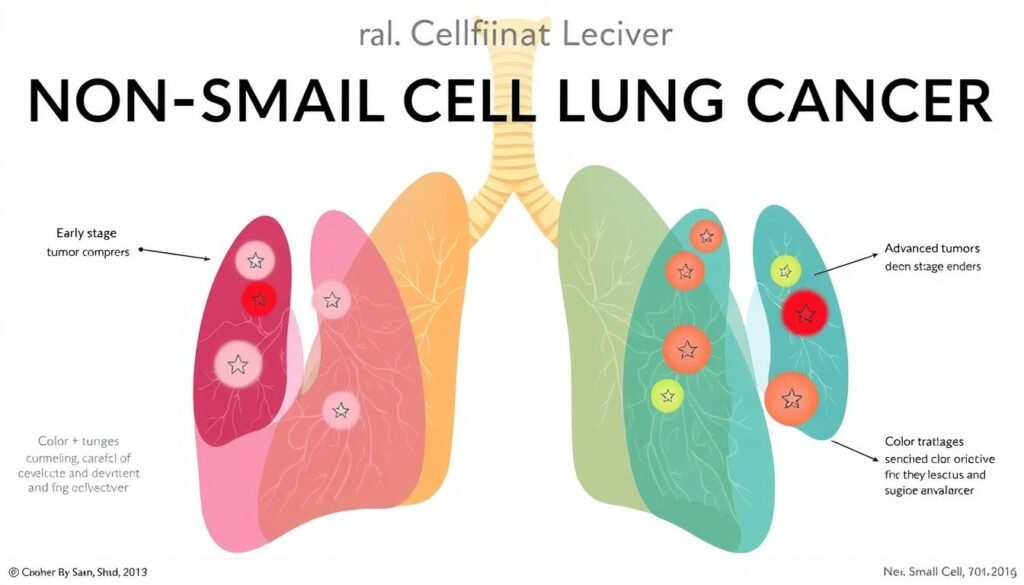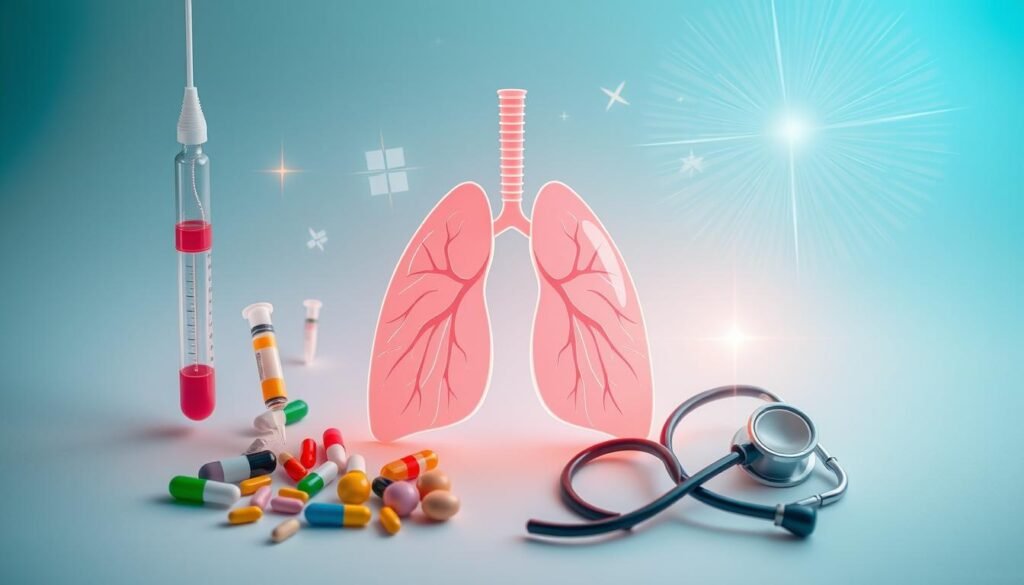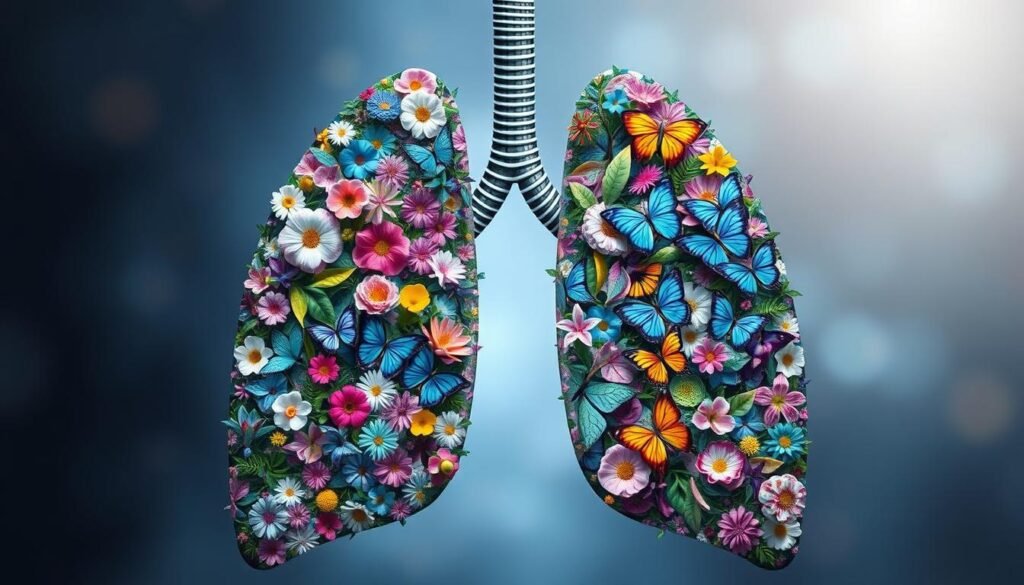Did you know that non-small cell lung cancer (NSCLC) accounts for 85% of all lung cancer cases? It is the most common form of lung cancer. It greatly influences survival rates and the treatments patients receive. Understanding NSCLC survival is key for those newly diagnosed and their families. Sadly, more than half of the patients pass away within a year of finding out they have lung cancer. The 5-year survival rate stands at just 17.8%. This fact highlights the urgent need for early diagnosis and treatment plans that cater to the individual.
In this article, we explore NSCLC. We’ll look at cancer staging, treatments, and what affects how long patients may live. This information can help patients, caregivers, and families feel more informed and in control. For more specifics and advice, a visit to healthcare experts and reliable sources like the Canadian Cancer Society is a good idea.
Key Takeaways
- NSCLC is the most common form of lung cancer, comprising 85% of all cases.
- Half of lung cancer patients die within a year of diagnosis, emphasizing the need for prompt medical intervention.
- Early-stage NSCLC shows a significantly higher survival rate compared to advanced stages.
- Understanding individual prognosis is key to making informed treatment decisions.
- Consult healthcare professionals for accurate information tailored to specific situations.
- Various treatment options like surgery, chemotherapy, and targeted therapy can improve survival chances.
Understanding Non Small Cell Lung Cancer
Non-small cell lung cancer (NSCLC) makes up about 85% of lung cancer cases in the U.S. It includes several lung cancer types. Adenocarcinoma is the most common, making up 40% of NSCLC cases. About 25% to 30% are squamous cell carcinoma, and large cell carcinoma is 10% to 15%.
Many risk factors for NSCLC exist. These include smoking, secondhand smoke exposure, radon gas, and working with asbestos. Symptoms like a persistent cough, chest pain, fatigue, and losing weight without trying are common. Catching these signs early can greatly help in treating the disease.
It’s very important to find NSCLC early. The 5-year survival rate is 65% when found early but locally. It falls to 37% for regional cases and 9% for metastasized cases. Treatments for NSCLC cover surgery, ablation, radiation, chemotherapy, targeted therapy, and immunotherapy. Each treatment is key for managing the disease.
| Lung Cancer Type | Percentage of NSCLC Diagnoses |
|---|---|
| Adenocarcinoma | 40% |
| Squamous Cell Carcinoma | 25% – 30% |
| Large Cell Carcinoma | 10% – 15% |
Stages of Non Small Cell Lung Cancer
Lung cancer staging is key in figuring out the disease’s progress and treatment options. Knowing the stages helps with diagnosis and impacts the outlook for non small cell lung cancer prognosis. The stages go from 0 to 4. Each one shows different tumor sizes and if the cancer has spread.
Overview of Lung Cancer Staging
Staging puts lung cancer into clear categories. This makes understanding the disease’s severity easier. Here’s a quick overview:
| Stage | Description | 5-Year Survival Rate |
|---|---|---|
| 0 | Localized to the airway lining (Tis, N0, M0) | Not available |
| IA1 | Minimally invasive adenocarcinoma, size ≤ 3 cm | 90% |
| IA2 | Tumor size between 1-2 cm, no lymph node involvement | 85% |
| IA3 | Tumor size between 2-3 cm, still localized | 80% |
| IB | Tumor size > 3 cm but | 73% |
| IIB | Tumors not larger than 3 cm with lymph node invasion | 56% |
| IIIA | Nodes involved around bronchus, no distant spread | 41% |
| IIIB | Advanced nodal involvement, localized | 24% |
| IV | Distant metastasis | 10% |

Impact of Stage on Treatment Options and Survival
Every stage of non-small cell lung cancer affects treatment options and survival rates. Early stages, like Stage 0 or IA, usually have a good non small cell lung cancer prognosis. This is because the disease has not spread much. Surgery, especially a lobectomy, is often the main treatment for Stage 1.
As the disease moves to later stages, treatment gets harder. It may include chemotherapy or targeted therapies. Survival rates also go down. For example, Stage 4 lung cancer, which means it has spread far, has survival rates drop to about 3%. Understanding the stages shows why finding the disease early is crucial for better survival chances. Getting into clinical trials for new treatments can also help patients facing lung cancer staging.
Lung Cancer Treatment Options
Treatment for non-small cell lung cancer depends on the disease stage and patient factors. A variety of methods may be used to meet each patient’s unique needs.
Surgery as a Treatment Solution
In early stages, surgery is often the key treatment, especially for stage 0 to potentially cure it. For more advanced stages, surgery can still be important. It’s usually combined with other treatments to improve outcomes.
Role of Chemotherapy and Radiation Therapy
Chemotherapy and radiation therapy are often used together in later stages. This approach targets cancer cells more effectively. For stage II NSCLC, neoadjuvant chemotherapy prepares patients for surgery.
Targeted Therapy for Lung Cancer
Targeted therapy uses drugs aimed at specific genetic mutations in cancer cells. Genetic testing for mutations is common before starting targeted treatments. This strategy leads to more tailored and effective treatment.
Immunotherapy as a Treatment Method
Immunotherapy is a newer option that boosts the body’s immune fight against cancer. It can be used alone or with other treatments, like chemotherapy, for stages IIIB and IV. Its flexibility makes it key in lung cancer treatment.

To understand lung cancer treatment options and effectiveness, early detection is key. Knowing symptoms early can greatly affect outcomes. Awareness of early signs benefits treatment paths.
Non Small Cell Lung Cancer Survival Statistics
Understanding lung cancer survival rates is vital for those facing non-small cell lung cancer (NSCLC). It’s the most common type, making up 80% to 85% of all lung cancer cases. The 5-year relative survival rate for NSCLC is about 25%.
However, early detection boosts survival rates to 63%. This shows how crucial early intervention is.

Lung cancer is a major health issue in the US, with an estimated 234,580 new cases in 2024. The American Cancer Society also predicts about 125,070 deaths. Most patients are diagnosed around the age of 70.
For men, the risk of getting lung cancer is 1 in 16. For women, it’s 1 in 17. This highlights the widespread impact of the disease.
| Stage at Diagnosis | 5-Year Survival Rate |
|---|---|
| Localized | 63% |
| Regional | 35% |
| Distant | 6% |
Many factors affect cancer prognosis and survival. For example, NSCLC patients with endobronchial metastatic lesions (EML) have shorter survival times. They have a median survival of 12 months, compared to 20 months for those without EML.
Genetic factors like EGFR mutations also play a significant role. Patients with these mutations often have better outcomes.
Thankfully, treatment methods continue to improve. Ongoing clinical trials are aiming to increase survival rates. So, staying updated on lung cancer research is key for patients and their families.
Lung Cancer Prognosis Factors
It’s crucial to understand the factors that affect lung cancer prognosis. This knowledge helps both patients and healthcare workers. For non-small cell lung cancer, the stage and genetic mutations at diagnosis play a big role. These aspects significantly shape treatment choices and chances of survival.
How Each Stage Affects Prognosis
The stage of lung cancer at diagnosis is key to prognosis. Early-stage patients usually live longer. For example, stage I lung adenocarcinoma patients have a better outlook. This is particularly true when few lymph nodes are involved. The American Cancer Society shows survival rates vary greatly with the stage. This underlines the value of catching the disease early.
Role of Genetic Mutations in Prognosis
Genetic mutations, especially in the EGFR gene, change how well treatments work and the overall outlook. Targeting these mutations can make treatment more effective. Studies highlight that knowing a patient’s genetic details can guide more personalized therapies. This approach helps in improving survival rates. Research like evaluations of treatment outcomes shows these factors are vital. They predict lung cancer prognosis better with newer treatments.
Clinical Trials and Advances in Treatment
Advancements in treating lung cancer come from ongoing research and clinical trials. These studies are key to new therapies and better treatment methods. They show our dedication to finding new solutions and improving how patients fare.
The Importance of Ongoing Research
Research is vital for finding effective treatments. Clinical trials give patients access to new therapies that meet their needs. These trials bring novel immunotherapies and targeted therapies, using machine learning to get more accurate diagnoses. The result is often a big boost in survival rates and life quality for lung cancer patients.
Latest Innovations in Lung Cancer Treatments
New treatments for lung cancer are always being developed. The introduction of drugs like alectinib and osimertinib has changed patient care for the better. Targeted therapies for MET and RET gene mutations have also been successful, leading to longer periods without disease progression. Patients in clinical trials can get these new treatments, sometimes doing much better than with standard treatments.
There’s been huge progress in immunotherapy too. The FDA has approved using immunotherapy as additional treatment after surgery, showing strong belief in its benefits. Adding these new methods to treatment plans offers a great chance to improve survival rates and patient experiences over time.
Living with Non Small Cell Lung Cancer
Managing non-small cell lung cancer involves navigating various emotional and physical challenges. Patients may find themselves confronting a range of feelings, including stress, anxiety, and fatigue. Prioritizing emotional well-being during treatment can significantly impact overall health and recovery.
Emotional and Physical Well-being
It is essential for patients to focus on their emotional health while fighting non-small cell lung cancer. Joining support programs made for cancer patients can offer comfort and understanding. Activities that improve mental health, like mindfulness meditation, yoga, and exercise, help with emotional stability.
Also, professional counseling can aid in coping with cancer’s psychological impacts. It offers strategies to manage anxiety and depressive thoughts.
Support Systems and Resources Available
Many support systems and resources are available to help those battling non-small cell lung cancer. Organizations like the American Cancer Society provide valuable info, counseling services, and local support groups. They connect patients with others in similar situations. Support from friends and family is crucial in building resilience during treatment.
Research shows that social support can improve coping mechanisms and quality of life for cancer patients.
| Resource Type | Description | Example Organizations |
|---|---|---|
| Counseling Services | Professional therapists offer emotional support and coping strategies. | American Cancer Society, Cancer Support Community |
| Support Groups | Gatherings for patients to share experiences and support one another. | Lung Cancer Support Group, Online Forums |
| Educational Resources | Information about cancer treatment and patient rights. | National Cancer Institute, CancerCare |
| Financial Assistance | Programs to help with surgery, medical bills, and transportation. | Patient Advocate Foundation, Good Days |
Accessing these resources can make a big difference in a patient’s journey, making the challenges of non-small cell lung cancer more manageable. Using emotional well-being strategies with physical treatments creates a complete approach to care.
Non Small Cell Lung Cancer Survival: What Patients Should Know
Being diagnosed with non-small cell lung cancer (NSCLC) brings many challenges. Patients benefit from understanding cancer treatment planning. It helps them make smart choices about their care. Talking with doctors about treatments, side effects, and new therapies is key.
Self-care is also crucial for well-being. Keeping up with doctor visits helps monitor progress. Getting involved in non small cell lung cancer survival tips can make patients stronger. For some, clinical trials provide access to the latest treatments.
Life changes, like eating well and staying active, support recovery. Research shows nutrition and exercise help patients handle treatment better and improve life quality. Meeting the unique needs of each patient is vital for success.
When chemotherapy is used, survival rates can vary. Patients on chemotherapy often live longer. They have a median survival of 4.8 months compared to 2.4 months for those not treated. For more details, check out the National Cancer Institute.
| Factor | Impact on Survival |
|---|---|
| Performance Status (PS) | PS 3-4: 39% received first-line chemotherapy |
| Gender | Female: HR of 0.71 (lower risk of death) |
| Aging | Mean age of cohort: 67.6 years |
| Race | 66% White, 31% Black |
Combining treatment with lifestyle changes helps individuals with NSCLC. Learning about genetic testing and adopting healthy habits are important. This way, patients can take control of their health journey.
Conclusion
Understanding non-small cell lung cancer (NSCLC) is crucial for patients and their families. This article sheds light on survival rates and the progress in treating lung cancer. It also talks about how important support systems are.
Patients gain insight into their cancer’s stages and what affects their chances of survival. They learn that being proactive, like getting treatment early and joining clinical trials, can help a lot. The availability of advanced treatments is also improving people’s chances of beating NSCLC.
Dealing with lung cancer is tough, but having the right information and support makes a big difference. Staying informed lets people choose treatments that fit their goals and improve their lives, despite the complexity of this disease.